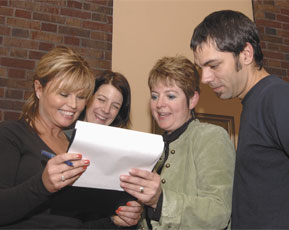 |
| Cynthia Barkhouse-MacKeen (third from left) with students from her second-year nursing class, Knowledge and Process in Nursing Practice (Danny Abriel photo) |
As a clinical nurse specializing in neurological nursing, Cynthia Barkhouse-MacKeen thrives “at the bedside.” She loves the complexity of the challenges she faces and her ability to make a difference in the lives of patients.
But, just as much, she likes “the light bulb moments” she witnesses while teaching, those moments when understanding dawns across a student’s face.
“It’s very exciting to be teaching them at the very beginning of their careers,” says Prof. Barkhouse-MacKeen, who brings more than 25 years of nursing experience to the classroom. “I’ve transferred some of the satisfaction of patient care to taking care of students. I like to think I’m making a difference with more patients because of all the students I’ve taught. It is a privilege to be a part of their learning.”
Winner of the 2007 Faculty of Health Professions Teaching Excellence Award, Prof. Barkhouse-MacKeen’s teaching philosophy is all about being the best role model she can be. All the things she stresses to her students about nursing practice—the ability to ask the right questions, to listen, to observe carefully, to think critically – are what she demonstrates in her teaching. She teaches several second-year classes: Pharmacology and Nursing (NURS 2050), Knowledge and Process in Nursing Practice with Clinical Application (NURS 2240) and, in the summer at the neurosurgery unit at the Halifax Infirmary, the clinical practicum Nursing Practice II (NURS 2220).
She delivers her lecture—on this day it’s about the examination of the skin—from the front of the lectern instead of behind it. Skin, she says, is a good indicator of overall health. Although there are more than 120 students in the class (NURS 2240), she seems to be attentive to each of them: throwing out questions to stimulate discussion and answering a frantically waving arm at the back of the lecture hall. After class, there’s a line-up 10 deep to speak to her.
Information conveyed during lectures is reinforced during lab sessions using interactive strategies and small group demonstrations. One student poses as a patient, one student conducts an examination and a third watches and gives feedback.
